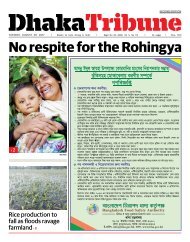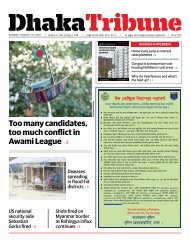e_Paper, Tuesday, December 13, 2016
You also want an ePaper? Increase the reach of your titles
YUMPU automatically turns print PDFs into web optimized ePapers that Google loves.
2<br />
TUESDAY, DECEMBER <strong>13</strong>, <strong>2016</strong><br />
DT<br />
News<br />
LEAD STORY<br />
A screen shot of a video footage shows a member police setting fire to the houses of Santals in November<br />
New video shows police<br />
role in Santal arson<br />
• Tribune Desk<br />
In light of new evidence, police are<br />
seen to be directly responsible for<br />
setting fire to the Santal houses in<br />
Gaibandha in November.<br />
A video acquired by Bangla<br />
Tribune, available at www.<br />
dhakatribune.com, shows a<br />
platoon of armed policemen<br />
marched towards an abandoned<br />
Santal village. The police kicked on<br />
the doors as if carrying out a raid<br />
on a militant den.<br />
Finding the huts unoccupied, a<br />
handful of policemen proceeded to<br />
set fire to the houses.<br />
The villainous act was matched<br />
solely by the ineptitude shown by<br />
the police as they fumbled in lighting<br />
a fire.<br />
One of the civilians accompanying<br />
the police then proceeds to<br />
set the house on fire, and within a<br />
matter of hours, the whole village<br />
is ablaze.<br />
The police and their civilian cohorts<br />
strolled nonchalantly amid<br />
the burning huts – an honest-to-<br />
God implementation of “scorched<br />
earth” policy – as part of a “clash”<br />
that has since killed three Santal<br />
men and displaced 2,000 families<br />
from their ancestral lands.<br />
On November 6, a clash was<br />
reported between the police and<br />
Santal community in Gaibandha.<br />
A sizable number of trained law<br />
enforcers bearing firearms against<br />
Santals with bow and arrows guaranteed<br />
the Santals would have to<br />
relent.<br />
The reason behind the conflict<br />
was revealed to be eviction of the<br />
Santals when they attempted to<br />
reclaim their lands granted to the<br />
Rangpur Sugar Mill which the Santals<br />
alleged the sugar mill reneged<br />
on the contract.<br />
Santals lament they were deceived<br />
by the local lawmaker who<br />
promised them his support in securing<br />
their lands. The same lawmaker,<br />
they alleged, was involved<br />
in the attack that saw a small-scale<br />
invasion in the form of police, Rab,<br />
sugar mill workers, local Bangalis,<br />
AL-JAZEERA<br />
and many more essentially expel<br />
the Santals from their lands.<br />
In the wake of the initial conflict,<br />
15 Santal villages in the Shahebganj-Bagda<br />
area were raided<br />
by police and sugar mill authorities<br />
with the support of local politicians.<br />
Police filed a case against 42<br />
Santals arrested who were granted<br />
bail by the High Court.<br />
Although many human rights<br />
organisations have pleaded for<br />
justice to be carried out and<br />
the Santals be returned to their<br />
lands, the scorched earth remains<br />
witness to the schools burnt down<br />
and the BGB patrolling the fences<br />
affirm the land is anyone’s but the<br />
Santals’. •<br />
Deaths of<br />
land rights<br />
defenders<br />
treble<br />
• Thomson Reuters Foundation<br />
The battle over land and resources<br />
turned bloodier in the past year<br />
with treble the number of land<br />
rights defenders killed, amid fears<br />
the violence will get even worse.<br />
An average of nearly 16 farmers,<br />
indigenous people and advocates<br />
of land rights were killed every<br />
month through November worldwide,<br />
or three times the average in<br />
2015, according to advocacy group<br />
Pan Asia Pacific (Panap).<br />
From January to end-November,<br />
171 people were killed in relation to<br />
land rights, Panap’s data showed.<br />
At least 118 were detained<br />
through November, compared with<br />
82 last year, as conflicts with rural<br />
communities and indigenous people<br />
intensified.<br />
In the fight for land and the environment<br />
- which UK-based watchdog<br />
Global Witness calls “a new<br />
battleground for human rights”<br />
- communities are locked in deadly<br />
struggles against governments,<br />
companies and criminal gangs exploiting<br />
land for products including<br />
timber, minerals and palm oil.<br />
Global Witness documented 185<br />
murders in 16 countries last year, or<br />
more than three people a week being<br />
killed defending land, forests and<br />
rivers in the deadliest year on record.<br />
In Asia, the Philippines, Indonesia<br />
and Cambodia saw the most<br />
number of victims, while in Latin<br />
America, it was in Honduras, Bolivia<br />
and Peru, Panap data showed.<br />
Harassment and killing of land<br />
rights defenders in India are also on<br />
the rise.<br />
In Brazil, more than 20 land<br />
rights activists were killed as of<br />
August this year, according to the<br />
Pastoral Land Commission.<br />
But communities are fighting<br />
back. In Cambodia, for example, a<br />
group of farmers is at the centre of a<br />
landmark legal case that could change<br />
the way global corporations manage<br />
large-scale land acquisitions. •<br />
Investigator: Some Bangladesh Bank officials involved in heist<br />
• Reuters<br />
Some Bangladesh central bank officials<br />
deliberately exposed its computer<br />
systems and enabled hackers to steal<br />
$81million from its account at the Federal<br />
Reserve Bank of New York in February,<br />
a top investigator in Dhaka told<br />
Reuters on Monday.<br />
The comments by Mohammad<br />
Shah Alam of Dhaka Metropolitan Police<br />
(DMP) are the first sign that investigators<br />
have got a firm lead in one of the<br />
world’s biggest cyber heists.<br />
He said arrests are likely to take<br />
place very soon.<br />
On Thursday, the head of a Bangladesh<br />
government panel that investigated<br />
the heist said five bank officials<br />
were guilty of negligence but that they<br />
were only unwitting accomplices.<br />
Shah Alam told Reuters his investigations<br />
had discovered that some<br />
bank officials had knowingly created<br />
vulnerabilities in the bank’s connection<br />
to the Swift system, used for global<br />
transactions.<br />
“Bangladesh Bank’s Swift network<br />
was made insecure by some bank employees<br />
in connivance with some foreign<br />
people,” he said. “They knew what<br />
they were doing.”<br />
He said investigators were now<br />
trying to find out how the mid-ranking<br />
officials were connected to the hackers<br />
and whether they benefited financially<br />
from the heist. Asked if the officials<br />
would be arrested, Shah Alam said:<br />
“We are very close to it.”<br />
Bangladesh Bank spokesman Subhankar<br />
Saha declined to comment.<br />
Another investigator, who declined<br />
to be named, said more than<br />
100 Bangladesh Bank employees had<br />
been interviewed in connection with<br />
the heist, and some were barred from<br />
leaving the country.<br />
The hackers used fake orders to order<br />
the transfer of nearly $1billion from<br />
Bangladesh Bank’s account at the New<br />
York Fed, using the international Swift<br />
payments network.<br />
Many of the transfer orders were<br />
blocked or reversed but $81million was<br />
successfully transferred to four fake<br />
accounts in a branch of Rizal Commercial<br />
Banking Corp (RCBC) in the Philippines.<br />
Most of the funds then disappeared<br />
into Manila’s loosely regulated<br />
casino industry. •


















